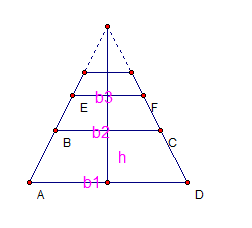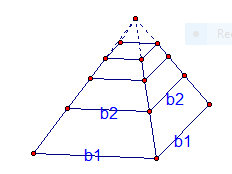I discovered this way of finding the formula for a
truncated pyramid or cone, known as a frustum, by using geometric
series. It is certainly not the standard way of deriving the
equation, but I liked the way it works out. I hope you will also.

The two dimensional version of this is to find the
area of a trapezoid, so let's start with finding the area of a
trapezoid using geometric series and then extend the result to 3
dimensions. The procedure used to find the area of a
trapezoid will be a bit roundabout, but it will be very easy to extend
the results to 3 dimensions.
Area of Trapezoid
The strategy for finding the area of the trapezoid is to build a
triangle by layering copies of the trapezoid as show in the
illustration. We will use the geometric series to express the
area T of the triangle in terms of the base trapezoid .
We will then find another geometric series to find the area
of the triangle. Equating the two expressions for
the area of the triangle allows us to solve for the area of the
trapezoid.

The trapezoid whose area A we want to find is ABCD given the lengths of
the two bases b1 and b2 height h. The
trapezoid BEFC above
ABCD has b2 for its bottom base instead of b1. We want trapezoid BEFC to be similar to ABCD. Since b2 is the bottom base for BEFC, the scaling factor r = b2/b1. By taking the height of BEFC to be rh, it will be similar to ABCD. The scaling factor
for the next trapezoid
applies the scaling factor r to BEFC and so has a scaling factor of r2. b3 = r2 b1
and for the nth trapezoid the scaling factor will be rn.
The next thing we want to do is to find the area of the nth trapezoid
in terms of A, r and n. Since the scaling factor is rn and
area is proportional to the square of the scaling factor, the area of
the nth trapeazoid is (rn)2A
= (r2)nA .
The area of the triangle is therefore:
T = A(1 + r2 + (r2)2
+ (r2)3 + ...).
This is just an infinite geometric series in r2,
so we get area of of triangle =
T = A/(1 - r2)
--- ( equation 1)
Next, let's find the area of the triangle in terms of b1 and h, using a
geometric series to find the altitude H of the triangle in terms of h.
The scaling factor of r again applies, and so we get H = h(1
+ r + r2 + r3 + ...) =
h/(1 - r).
The area of the triangle is therefore T = 1/2 b1 H = 1/2 b1 h /(1 - r).
----- (equation 2)
We could at this point substitute b2/b1
for r in the last
expression for the area of the triangle, but let's keep it in terms of
r and equate the two expressions for the area of the triangle.
Equating equation 1 with equation 2 gives
A/(1 - r2) = 1/2 b1 h /(1 - r)
A = 1/2 b1 h (1 - r2)/ (1 - r)
(1 - r2)/ (1 - r) simplifies to (1 + r). Notice that (1 - r2)/ (1 - r) is a speical case of the formula for geometric series. (1 - r(n+1))/ (1
- r). In this case, n = 1 giving the very short geometric series 1 + r.
This idea will be more useful when we get to the three
dimensional case.
Using the simplification, we get
A = 1/2 b1 h (1 + r)
Substituting b2/b1 for r, A = 1/2 b1 h (1 + b2/b1) = 1/2 h (b1 + b2), which is the standard formula for the area of a trapezoid.
Volume of Frustum
It is now relatively easy to find the volume of a square truncated pyramid using the technique we used for trapezoids.

We have b1 for the lower base sides and b2
for the upper base sides. h is again the height and V is the
volume that we want to find. When we stack up the truncated bases
in an infinte series we get a pyramid. The scaling factor is
again r = b2/b1 and once again the scaling factor for the nth figure is rn. The volume of the nth figure is proportional to the cube of the scaling factor, and so will be V(rn)3 = V(r3)n. The volume P of the pyramid is V(1 + r3 + (r3)2 + (r3)3 + (r3)4 + ...), which is a geometric series in r3, so P = V/ (1 - r3).
The height of the pyramid is h/(1 - r) , Using this in the formula for the volume of a pyramid, P = 1/3 b12 h./(1 - r)
Equating the two equations for P:
V/ (1 - r3) = 1/3 b12 h./(1 - r)
V = 1/3 b12 h (1 - r3)./(1 - r)
Recognizing (1 - r3)./(1 - r) as the formula for a geometric series, substituting for r and simplifying gives us:
V = 1/3 b12 h (1 + r + r2) = 1/3 b12 h (1 + b2/b1 +b22/b12) = 1/3 h (b12+ b1b2 + b22).
Do
you see a pattern in going from two dimensions to three dimensions?
What would you expect the formula to be in four dimensions?
Volume of Square Pyramid
We have been using the equation for the volume of a square pyramid as 1/3 b12 H. We can non-rigorously derive this formula based on the work we did with the frustum. The assumption we will be will
be making is that the volume is proportional to the height and to the
area of the base. You can convince yourself that this is the case
if you consider the intersection of the altitude with many parallel planes perpendicular to the altitude and a fixed distance apart,
We can approximate the volume as the sum of rectangular prisms,
each formed by one of the two bounding planes and the height between
them. If we stretch the height, we will get a propotional
increase in the height between the planes. Similarly, stretching
each coordinate of the base will proportionately increase the volume . Summarizing, assume that the volume is kb12 H. We want to show that k = 1/3.
Replacing 1/3 with k, we have the volume of the frustum as V = k h b12 (1 + r + r2) , where r = b2/b1 Consider what happens as b2 approaches b1 and r aproaches 1. We can't have r =1, because (1 - r3)/(1 - r) = (1 + r + r2) only holds when r does not equal 1.
As r approaches 1, the frustum becomes a rectangular prism with volume V = h b12. The frustum formula for r approaching 1 gives V = k h b12 (1 + r + r2) = 3 k h b12. Equating the rectangular prism equation with the frustum equaation gives h b12 = 3 k h b12 Simplifying, 3k = 1, k = 1/3, as we intended to show.